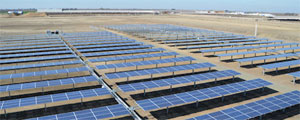More big utility-scale solar PV projects are on the horizon in Nevada, where 480 megawatts (MW) have been approved by the Bureau of Land Management (BLM).
Three companies won BLM’s competitive solicitation: First Solar (200 MW); Invenergy (130 MW) and NV Energy, Nevada’s biggest utility (150 MW).
Earlier this year, NV Energy announced it would close four coal plants and re-direct investments to renewable energy and natural gas.
Located in Nevada’s Dry Lake Solar Energy Zone, about 15 miles north of Las Vegas, they are near the 392 MW Ivanpah concentrating solar plant, which came online earlier last year.
They have easy access to transmission lines that carry energy to California and Arizona.
Last week, First Solar started construction on another major project, the 250 MW Silver State South near Primm, Nevada, which will supply power to Southern California Edison under a 20-year contract. First Solar is also building the 250 MW Moapa Southern Paiute project in southern Nevada under a 25-year contract with Los Angeles Department of Power.
Moapa project:

Read our article, Nevada’s Innovative Incentives Helping it Lead on Renewable Energy.
Google Invests in Solar Again
In California, Google is making yet another investment in a solar project, this time $145 million in the 82 MW Regulus solar plant. SunEdison (NYSE: SUNE) is building it on a former oil and gas field site.
"We believe the world needs a wide range of clean energy technologies, each serving different needs. This project with SunEdison presented an opportunity to take an old gas and oil field and turn it into a clean energy producing solar site. It made sense to support it on multiple levels," says Nick Coons, renewable energy principal at Google.
It too will supply energy to Southern California Edison for 20 years when it comes online this year.
The project will be part of SunEdison’s yieldco, TerraForm Power (Nasdaq: TERP), which went public about a month ago with an 808 MW initial portfolio.
EPA’s RE-Powering America’s Land Initiative, launched in 2008, identifies contaminated land, landfills and mine sites that are appropriate for renewable energy. More than 10,000 sites would work for solar, for example, and over 70 renewable energy projects have so far been built on these lands.
